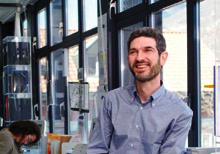on April 18, 2007

The work of Jeremy Luban to be published in Virology this year. Scientists at IRB have uncovered important new information about the molecular machinery used by HIV to infect cells.HIV is the cause of AIDS and information about how it infects cells is critical to the development of new ways for stopping this deadly disease.
HIV makes a protein called Integrase which is essential for this deadly virus. In other words, without Integrase,HIV-1 cannot infect people, and cannot cause AIDS. One of the sinister characteristics of HIV-1 is that it literally splices its genetic material into the chromosomal DNA where our genetic material is located. In effect, HIV becomes a gene like any other that we possess. It cannot be eliminated and remains a part of us as long as we live.
Integrase protein is the “machine” that HIV uses to splice itself into our DNA.Very much like a film editor who cuts a reel of film and splices in footage from a newly filmed scene, Integrase cuts our chromosomal DNA and inserts viral DNA into the gap. It has been known for some time that Integrase must also process the two ends of the viral DNA before this splicing event can be successful. How Integrase can process both ends of the viral DNA at the same time has been an ongoing mystery but it is believed that 4 Integrase molecules associate with each other in order to accomplish this complex task.The discovery by the IRB researchers explains how 4 Integra-se molecules associate with each other.They show that by disrupting the association of these 4 molecules the virus is no longer able to reach the DNA-containing nucleus of the cell and thus fails to infect the cell.
Currently, AIDS can be prevented in HIV-infected people with drugs that block HIV proteins called reverse transcriptase and protease. HIV Integrase offers a new target for anti-HIV drugs; the first drugs of this class are currently under review by regulatory agencies in the USA.







